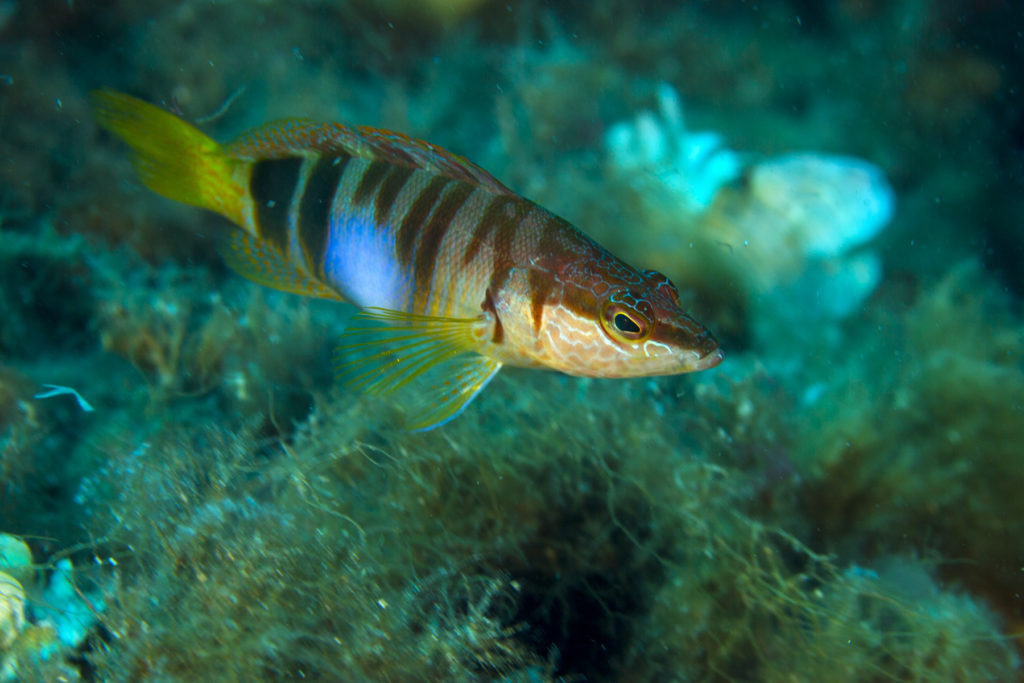Glimmers of Hope from an Ancient World
August 16, 2017
by Courtney Mattison
Undulating in the clear cerulean water, long blades of Posidonia oceanica seagrass glittered green through the window of my scuba mask. As I sank among them, I felt as if I could disappear within their dense, elongated strands. I peered down and discovered a painted comber (Serranus scriba), twenty-five centimeters long, staring back at me from its hiding spot. Gazing ahead to the other divers in our group, I spotted a golden yellow brittle star climbing up the arm of Manu San Félix, an underwater filmmaker and marine biologist who was our guide on this dive.
“The first time you jump on a place with Posidonia and you look through your mask, you will see a green meadow,” remarked Manu San Félix after the dive. He continued:
It looks like there’s not that much life. The Posidonia is a real jungle, but the life, it’s inside. But we are too big to go inside. If we could make ourselves small… then we would have the opportunity to go inside. So when I dive in the Posidonia that’s the reason why I’m always opening the leaves and looking inside for all this life inside that is full of sponges, sea urchins, starfishes, moray eels, groupers—it’s an incredible world. A thousand species depend on Posidonia to survive.
Posidonia oceanica meadows are found off the shores of Formentera and Ibiza in Spain’s Balearic Islands Hope Spot, where Mission Blue Director of Photography and Expeditions, Kip Evans, led the latest Hope Spot Expedition. Endemic to the Mediterranean Sea, Posidonia oceanica grows its blades to peak length in the summer, reaching up to two meters and creating dense thickets where a wide variety of fish and invertebrate species find shelter, food and mates. The plants—also known as Neptune Grass—then shed their long leaves and begin growing new ones throughout the winter. Discarded leaves wash onto beaches and protect them from erosion. Calcareous epiphytes that live on the leaves fall off and fertilize the sand dunes.

While the blades of Posidonia seagrass grow quite quickly, the plant as a whole is among the slowest-growing and longest-living plants in existence. “The Posidonia meadows we see are very very long-lived,” says Dr. Núria Marbà, a Posidonia expert from the Department of Global Change Research at the Mediterranean Institute for Advanced Studies (IMEDEA), a research center jointly governed by the Spanish National Research Council (CSIC) and the University of the Balearic Islands (UIB). She continues:
In fact, all we see are clones [of the same] plant… They can extend several kilometers and since the growth of the plant is very slow, this what indicates to us is that these clones are so extensive they can be several tens of thousands of years old.
The high productivity and structure of these plants—which Dr. Marbà notes only grow up to 5-6 centimeters per year—make them valuable carbon sinks, as they capture carbon dioxide and sequester it,in reefs constructed by their rhizomes. A Nature paper co-authored by Dr. Marbà reported that although seagrass in general only covers 0.1% of the seafloor, it accounts for 10-18% of total marine carbon sequestration. This type of carbon capture performed by marine life, known as “blue carbon,” is a crucial part of the global carbon cycle that limits the amount of greenhouse gases accumulating in the atmosphere, thereby mitigating climate change.
Despite the ability of Posidonia to help combat global warming, these ancient plants are also increasingly victims of it. Posidonia is quite sensitive to warming sea temperatures, and the Mediterranean Sea is warming very quickly. Already scientists are observing notable decreases in the size and health of Posidonia colonies, which are simultaneously impacted by water pollution, anchor damage and other threats. Dr. Marbà is concerned that climate change models predict temperatures that may leave the Mediterranean with “very little Posidonia during the second half of the 21st Century.” “However,” she says, “we still have very important Posidonia extensions and meadows in good condition, which is very important to conserve the meadows we have.”
The Posidonia meadows between the Balearic Islands of Formentera and Ibiza were inscribed as a UNESCO World Heritage Site in 1999, and are protected within the Ses Salines Natural Wildlife Reserve. The Mediterranean is notoriously overfished and under-protected, yet local governments, nongovernmental organizations and stakeholders here are working hard to do what they can to safeguard this precious seagrass ecosystem from such threats as harmful fishing practices and anchor damage. With hundreds of luxury yachts frequenting these waters each day, the latter is of key concern as a single misplaced anchor can destroy thousands of years worth of Posidonia growth in one drag.

Continuing to protect and study this fragile ecosystem is imperative to sustain and restore the health of the Balearic Islands Hope Spot, and the Mediterranean as a whole. Dr. Marbà notes, “… it is a key ecosystem in the functioning of the Mediterranean. And we have to know to the maximum how this ecosystem works… to enjoy [it] in the future.” Enforcing and expanding marine protected areas (MPAs) in the region must be a priority. Strongly protected MPAs are known to help alleviate the impacts of climate change and overfishing, among other human-caused threats, and may help safeguard Hope Spots such as this for the future. As our dive guide Manu San Félix says, “I would like my kids and the people who will be here in 25 or 30 years to have this treasure.”
Special thanks to French luxury skincare brand, Biotherm, for sponsoring this expedition. Thanks also to Vellmari Diving in Formentera for keeping our team safe and informed on the water, and to Dr. Núria Marbà and Manu San Félix for sharing their important work.







